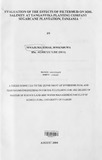| dc.description.abstract | This study was undertaken to evaluate the effect of filtermud on selected chemical and
physical properties of an irrigated salt-affected soils under field conditions. Three fields (04.
lOA and control) were selected for this study at Tanganyika Planting Company Ltd,
(Tanzania). Representative soil sampling sites were selected to represent irrigated salt
affected soil from abandoned field lOA, irrigated salt affected soil reclaimed with filtermud
from field 04 and non irrigated soil from control field. The effect of water quality
management on soil properties was also evaluated.
Mean infiltration rate. saturated hydraulic conductivity and moisture retention varied
significantly within fields (P < 0.05). The initial infiltration rates were 180, 120 and 60 cm/hr,
for control. 04 and lOA fields respectively while the corresponding steady-state infiltration
rates were 36. 9 and 5 ern/hr. Saturated hydraulic conductivity values for top soils were
27.3cmlhr for control; 4.3cm/hr for field 04; and 2.0 cmlhr for field lOA while the
volumetric water content retained at 300 and 1500 KPa. were 0.21. 0.25 and 0.30 cm'zcm'
and 0.91.0.21 and 0.24 cm3/cm3 for control. 04 and lOA fields respectively.
Electrical conductivity values for topsoil from field 04 were significantly low (P<0.05) as
compared to that of field lOA with mean values of 0.6 dsm", 0.8 dsm" and 3.7 dsm" for
control. reclaimed and abandoned fields respectively. The pH of the topsoil from field 04
was low compared to that of soils from field lOA with mean values of 7.5. 8.0 and 8.9 for
control. 04 and lOA fields respectively. Calcium ion content was high in soils from the
filtermud-applied field as compared to the abandoned salt affected field. Exchangeable
sodium percentage (ESP) mean values for the topsoils were 4.1. 12.8 and 40.0 for control. 04
and lOA fields respectively. Similarly the sodium adsorption ratio (SAR) values for topsoils
were 1.0. 3.8 and 10.5 for control, 04 and lOA fields respectively.
Vertical Ksat correlated positively and significantly (r :== 0.8) with sand fraction. Moisture
retention correlated positively and significantly with clay and silt fraction, with correlation
coefficient of 0.8 and 0.6 at 700 and 1000 KPa respectively. Also the moisture retention
correlated negatively with sand fraction at 700, 1000 and 1500 KPa with correlation
coefficient of 0.9~ Finally, percentage base. saturation was higher than 100 percent and
significantly correlated with exchangeable sodium content of the soil.
The water samples analyzed were regarded as being unsatisfactory for irrigation except water
from Weruweru River particularly on heavy textured soils, unless sufficient drainage is
provided and the necessary soil and water amendments are adopted. Therefore slightly poor
quality irrigation water, when used without sufficient drainage and management practice
under semi arid conditions has a adverse effect on light textured soils in the long run and may
turn the formerly fertile land into salt affected waste land. Filtermud provided significant
improvement for some soil properties especially the surface soils. Therefore the main
beneficial effect of this organic amendment is an increased infiltration rate and thereby
facilitating movement of chemical agents to deeper soil layer by the irrigation waters more
efficiently. | en |

